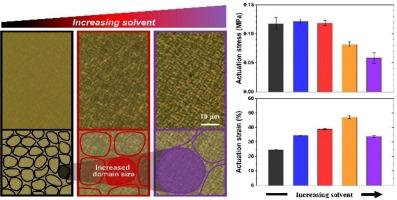Improved actuation of liquid crystal elastomers via solvent engineering
IF 6.3
2区 化学
Q1 POLYMER SCIENCE
引用次数: 0
Abstract
Liquid crystal elastomers (LCEs), soft elastic networks with liquid crystal molecules, exhibit notable energy-dissipating and shape memory properties. This study explored how removed solvent in post-polymerization influences the structural and actuation characteristic of LCEs. By systematically varying solvent content during synthesis and evaluating post-polymerization effects, we discovered that solvent levels critically modulate actuation strain and stress through mesogen mobility and cross-linking density. Higher solvent content increased actuation strain up to 38.6 %, maintaining actuation stress of 0.11 MPa, but diminished it at excessive levels due to reduced mesogen concentration. Structural analyses via polarized optical microscopy, positron annihilation lifetime spectroscopy, and WAXS underscored the formation of expanded mesogen domains and changes in mesogen rotation behavior. These insights offer a pathway for customizing the performance of LCEs, enabling more precise and adaptable soft actuators in next-generation technologies.

通过溶剂工程改进液晶弹性体的驱动
液晶弹性体(LCEs)是一种由液晶分子组成的软弹性网络,具有显著的能量耗散和形状记忆性能。本研究探讨了聚合后去除溶剂对lce结构和驱动特性的影响。通过在合成过程中系统地改变溶剂含量并评估聚合后效应,我们发现溶剂水平通过介质迁移率和交联密度对驱动应变和应力进行了关键调节。较高的溶剂含量可使驱动应力增加38.6%,保持0.11 MPa的驱动应力,但过高的溶剂含量会使驱动应力降低。通过偏振光学显微镜、正电子湮灭寿命谱和WAXS对其结构进行分析,强调了扩展介质畴的形成和介质旋转行为的变化。这些见解为定制lce的性能提供了一条途径,从而在下一代技术中实现更精确、适应性更强的软执行器。
本文章由计算机程序翻译,如有差异,请以英文原文为准。
求助全文
约1分钟内获得全文
求助全文
来源期刊

European Polymer Journal
化学-高分子科学
CiteScore
9.90
自引率
10.00%
发文量
691
审稿时长
23 days
期刊介绍:
European Polymer Journal is dedicated to publishing work on fundamental and applied polymer chemistry and macromolecular materials. The journal covers all aspects of polymer synthesis, including polymerization mechanisms and chemical functional transformations, with a focus on novel polymers and the relationships between molecular structure and polymer properties. In addition, we welcome submissions on bio-based or renewable polymers, stimuli-responsive systems and polymer bio-hybrids. European Polymer Journal also publishes research on the biomedical application of polymers, including drug delivery and regenerative medicine. The main scope is covered but not limited to the following core research areas:
Polymer synthesis and functionalization
• Novel synthetic routes for polymerization, functional modification, controlled/living polymerization and precision polymers.
Stimuli-responsive polymers
• Including shape memory and self-healing polymers.
Supramolecular polymers and self-assembly
• Molecular recognition and higher order polymer structures.
Renewable and sustainable polymers
• Bio-based, biodegradable and anti-microbial polymers and polymeric bio-nanocomposites.
Polymers at interfaces and surfaces
• Chemistry and engineering of surfaces with biological relevance, including patterning, antifouling polymers and polymers for membrane applications.
Biomedical applications and nanomedicine
• Polymers for regenerative medicine, drug delivery molecular release and gene therapy
The scope of European Polymer Journal no longer includes Polymer Physics.
 求助内容:
求助内容: 应助结果提醒方式:
应助结果提醒方式:


